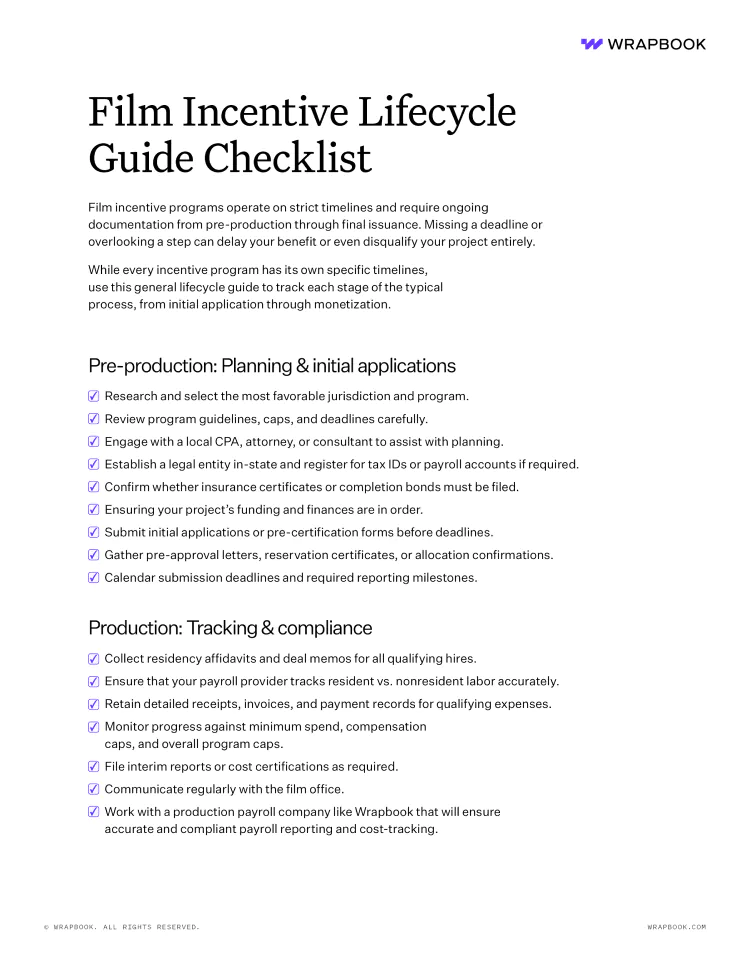

At Wrapbook, we pride ourselves on providing outstanding free resources to producers and their crews, but this post is for informational purposes only as of the date above. The content on our website is not intended to provide and should not be relied on for legal, accounting, or tax advice. You should consult with your own legal, accounting, or tax advisors to determine how this general information may apply to your specific circumstances.
A key goal of Program 4.0 has been to spread production activity beyond Los Angeles. The new incentives for out-of-zone filming are doing just that.
With 511 out-of-zone filming days—the most ever recorded—this round ensures that the economic benefits of production reach far beyond Hollywood. From the Bay Area to the Inland Empire and down to San Diego, 38 awarded projects will film across a wide range of California communities.

These productions will bring spending to local vendors, hotels, restaurants, and service providers while helping regional economies develop stronger film infrastructure and crew networks. As a result, more regions are poised to emerge as sustainable filmmaking hubs within the state.
For crew members, this surge of production marks a long-awaited turning point. After signs of slowing activity due to industry strikes and shifting production patterns, more work is on the horizon and it’s staying local.
For producers, California’s enhanced Film & Television Tax Credit Program offers predictability, scale, and an unparalleled ecosystem of talent and infrastructure. The record-breaking number of credits awarded to both large and small productions underscores the state’s renewed capacity to support projects of every size.
For vendors and support services—from equipment rental houses to catering companies—the increased volume of film activity means growing demand, particularly in regions outside Los Angeles that are now seeing more filming days than ever before.
The most recent feature film application window closed on October 29, 2025, but new opportunities are just ahead.
The next application periods for both film and television projects will open in 2026. Producers can find detailed information about eligibility, application timelines, and program requirements at the California Film Commission’s official website.
To prepare, productions should ensure that budgets are finalized, California spending estimates are well-documented, and job creation numbers are realistic and detailed.
With $342 million in new tax credit allocations to studio and independent features and record-breaking regional participation, California’s Film & Television Tax Credit Program 4.0 is already reshaping the state’s production landscape. For filmmakers, crew, and vendors alike, it’s clear: the Golden State is open for production.
To learn more about production incentives available in California and across the United States, visit Wrapbook’s Production Incentive Center. This comprehensive resource can help you discover and compare incentives, check eligibility, and learn how to harness the most from incentives on your next project.
California is once again in the production spotlight. Governor Gavin Newsom and the California Film Commission (CFC) recently announced the latest round of California Film & Television Tax Credit awards and the results are record-breaking.
Fifty-two feature films will receive $342 million in total tax credits with over $1.4 billion projected in economic impact statewide.
These awards represent the first major allocation of feature film credits since the launch of California’s expanded Film & Television Tax Credit Program 4.0 earlier this year. With increased funding and new eligibility provisions, the program is already proving transformative for producers, crews, and local economies across the Golden State.
In July 2025, the California Film Commission officially launched Film Tax Credit Program 4.0 with a host of significant enhancements aimed at expanding eligibility and drawing more production to the state.
Most notably, California more than doubled available funding, increasing the total amount of film tax credits available yearly from $330 million to $750 million.
With this round of tax credit awards—the first allocated to features under the new program—we can now see that the expansion is having a real impact.
Applications received in this window nearly doubled compared to Program 3.0’s last features round. From that applicant pool, the Commission awarded credits to 52 projects, the highest number of films ever awarded California film tax credits in a single round.

Of the 52 feature films allocated credits, ten are studio or non-independent projects, while the remaining 42 are independent productions. Of the 42 indies, 32 have budgets under $10 million, underscoring California’s renewed commitment to independent filmmaking.
And with $342 million in tax credits allocated across the 52 projects, funding in just this round dwarfed the program's previous annual funding cap of $330 million. In return, the state expects to see roughly $1.4 billion in combined production spending and wages from these 52 projects returned to local economies across California.
Collectively, the films are projected to generate $629 million in wages, employ 8,900 cast and crew members, and account for 46,400 background performer workdays over 1,664 filming days statewide.
Out-of-zone filming—that is, production activity outside the Los Angeles 30-mile zone—also hit a new milestone. This round saw 511 projected out-of-zone filming days, the highest in program history.
Thirty-eight of the awarded projects will film in counties including Alameda, Contra Costa, Imperial, Inyo, Marin, San Bernardino, San Diego, and Santa Clara, ensuring that production dollars flow across the state.
Together, these figures point to the growing scale, workforce reach, and geographic diversification of California’s incentive program. It’s a strong signal that the state remains committed to retaining and expanding its position as a global production hub.
The CFC awarded California film tax credits to both studio-backed projects and independent features in this latest round. Among the 10 major studio projects receiving tax credit allocations are some of the year’s most anticipated titles.
Sony Pictures’ untitled Jumanji sequel will return to California with a $162 million budget and $43.9 million in credits. Michael Mann’s Heat 2 earned $37.2 million in credits and will film largely in Los Angeles, the city its 1995 predecessor made home.
Netflix’s The Fifth Wheel, directed by Eva Longoria, also captured a California film tax credit allocation alongside Blumhouse’s Sunday, an adaptation of the acclaimed novel, and an untitled new project from the Oscar-winning Everything Everywhere All at Once directing duo, The Daniels.
Together, these projects are expected to inject hundreds of millions of dollars into the California economy, supporting thousands of film jobs and reaffirming the state’s ability to host large-scale, globally competitive productions.
For crews, vendors, and service providers, the message is clear: big-budget filmmaking is here to stay in California.
This latest round of film tax credit awards shows that indies, too, are thriving in California under Program 4.0.
Forty-two of the awarded projects are independent productions, including Epiphany starring Bill Murray and Kristen Wiig, The Incredible Heist of Hallelujah Jones produced by Taika Waititi and starring Janelle Monáe, Sun Baked featuring Ruby Cruz and Kiernan Shipka, and A Tree Is Blue produced by Dakota Johnson.
The credit allocations follow dramatically expanded support for independent productions under Program 4.0, which:
When these Program 4.0 upgrades were announced in July 2025, we predicted that the enhanced support for independent productions would encourage a boom of small—and mid-budget filmmaking in the state. So far, that’s proving true.
A record-breaking 43 indie films were allocated California film tax credits in July 2025. With 42 independent awardees in this latest round, the trend continues, confirming that California is now one of the most supportive states for independent production.
For producers and below-the-line workers alike, this surge signals growing opportunity across all budget levels.